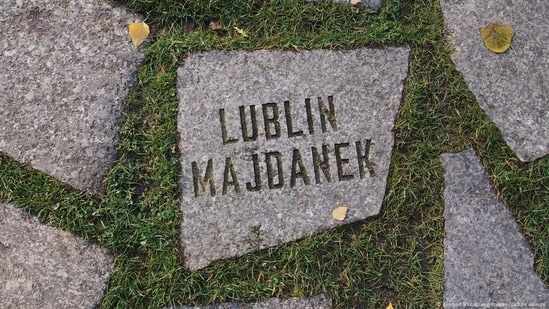
80 years on: Marking the liberation of Majdanek Nazi camp
5 months ago | 98 Views
Majdanek in Poland was the first Nazi concentration camp to be liberated, almost a year before the end of World War II.
On July 24, 1944, Soviet soldiers and Polish military units arrived at the Majdanek concentration camp on the outskirts of the city of Lublin in eastern Poland.
A US war reporter would later describe Majdanek as "the most terrible place on the face of the Earth," comparing it to a huge car factory "for the production of death."
Ahead of the arrival of the Red Army, the Nazis had hastily abandoned Majdanek, one of six purpose-built killing centers called extermination camps that the Nazis built in the area of Poland under German occupation. They evacuated the remaining prisoners and tried to destroy the crematoriums and other buildings in an attempt to cover up the mass murder that took place at the death camp.
A least 78,000 people, including 59,000 Jews, were killed at Majdanek during its nearly three years of existence.
"Shocking evidence of the crimes committed by the Germans was found: ashes, bones, human remains and the bodies of the murdered prisoners, mainly Jews and Poles," Wieslaw Wysok, the deputy director of the Majdanek State Museum, told DW.
"The tragic dimension of the site was further emphasized by the surviving traces of the crime: gas chambers, crematoriums, prisoners' barracks, hundreds of thousands of shoes."
The discovery of Majdanek provided clear evidence of the Nazi extermination system almost six months before the liberation in January 1945 of the Auschwitz concentration and extermination camp, where some 900,000 Jews were murdered in the gas chambers.
Nazi Germany killed some 6 million Jews between 1941 and the end of World War II in 1945 in the deliberate, systematic and state-sponsored murder of Jews known as the Holocaust. The Nazis also persecuted other groups, leading to the deaths of at least 1.9 million non-Jewish Polish civilians during the war.
Labor camp became an extermination camp
Initiated in July 1941 on the orders of top Nazi official Heinrich Himmler, Majdanek's original function was to serve as a prison of war and labor camp.
Within a year, it was converted into an extermination camp, where prisoners too weak to work were killed.
"From autumn 1942 to autumn 1943, Jewish prisoners were murdered with Zyklon B and carbon monoxide in gas chambers," said Wysok.
Majdanek was also one of the sites of the Holocaust's largest German-perpetrated massacre, known as "Aktion Erntefest" or "Operation Harvest Festival."
The operation saw some 42,000 Jews killed on November 3 and November 4, 1943, at Majdanek and two other camps in German-occupied Poland.
German police and SS units shot more than 18,000 Jews at Majdanek — nearly all of the remaining Jewish prisoners at the camp — as part of the operation.
Operation Harvest Festival was an element of a larger Nazi operation known as "Aktion Reinhardt," which was responsible for the systematic murder of 1.8 million Jews in German-occupied Poland.
"Lublin was the headquarters of 'Aktion Reinhardt,' the place where economic activities converged," said Stephan Lehnstaedt, a Holocaust studies professor at Touro University Berlin.
"This is where those Jews who were still needed for forced labor and could be exploited were allocated. This is where looted goods were sorted and processed. People were deported from there to other camps and everything was coordinated from there."
What was happening in Majdanek was known in Lublin. There were reports from people who had managed to escape from the camp, and also people who worked there.
Liberation of camp had no bearing on war trajectory
The first Western journalists were allowed to enter liberated Majdanek in August 1944, with the US magazine Life publishing an article calling the camp the worst example of organized cruelty in the history of civilization.
But this knowledge of the atrocities being carried out by the Nazis didn't alter the course of the war, said Lehnstaedt.
"Majdanek was directly on the route to [the German capital] Berlin. Nobody was on their way to liberate the concentration camps, but to fight against the Wehrmacht and defeat the Germans militarily," he told DW.
"The much-debated question is: Why weren't the tracks to Auschwitz bombed, why didn't anyone do anything, why didn't anyone protest? Because it played no role militarily."
Memorial museum came soon, but Nazi trials took time
Majdanek wasn't just the first Nazi concentration camp to be liberated, but it was also the first to be transformed into a memorial museum, commemorating the victims of National Socialism.
"Less than a month after the camp was liberated, an initiative was launched in Lublin to establish a museum," said Wysok. "The museum began its work at the beginning of November. Three years later, on July 2, 1947, the Polish parliament passed a law giving the Majdanek State Museum its legal status."
The first trial of Nazi officials at the Majdanek camp took place in November and December 1944. Six staff members were sentenced and hanged.
It took three more decades, however, before trials were held in West Germany against Nazis who had committed crimes at Majdanek.
From 1975 to 1981, six female guards, a male doctor and nine SS guards stood trial in Düsseldorf. It was one of the longest and most complex case in German judicial history.
Guard Hermine Braunsteiner-Ryan was sentenced to life imprisonment. Seven other defendants received prison sentences ranging from three to 12 years, while the others were acquitted.
"Some of the defendants were unfit to stand trial," said Lehnstaedt. "It had been too long. Furthermore, the German legal system at the time required proof of individual murder. And that was difficult to prove, because of course you needed a witness to say they saw exactly how this person killed a prisoner."
Majdanek 'overshadowed' by Auschwitz
Lehnstaedt deplored the fact that many Germans are no longer familiar with the name Majdanek. He said that apart from Auschwitz, people often didn't know about the other extermination camps in occupied Poland.
The media, he suggested, were partly responsible for this.
"German remembrance is very much focused on the Holocaust and Auschwitz. When German visitor groups make the long journey to Poland, they usually go to Auschwitz. Majdanek, like every other Polish memorial site, is simply overshadowed by Auschwitz."
Wysok from the Majdanek State Museum said the commemorations to mark the 80th anniversary of the camp's liberation would be attended by former prisoners — survivors who were children during the war. He said they would once again bear witness to ensure that the victims are never forgotten.
"There is a sentence engraved on the mausoleum where the ashes of the murdered were buried: 'Let our fate be a warning to you'.
"Even after 80 years, this is still relevant, because they are not just asking for the innocent victims to be remembered. They are still asking for their struggle to preserve their humanity under the most inhumane conditions to be remembered. And that we learn from their experience."
Read Also: best puzzle games for kids: 6 top picks for your child's development




















